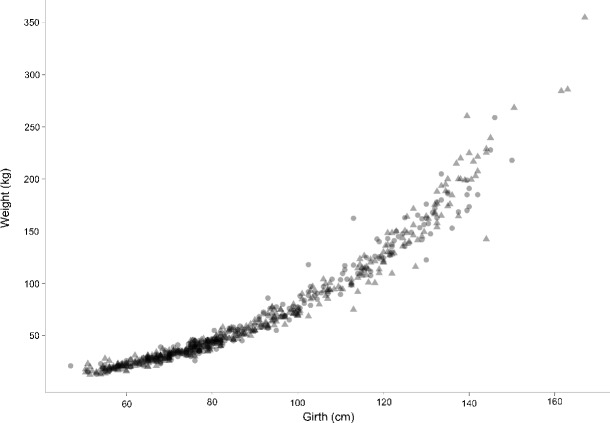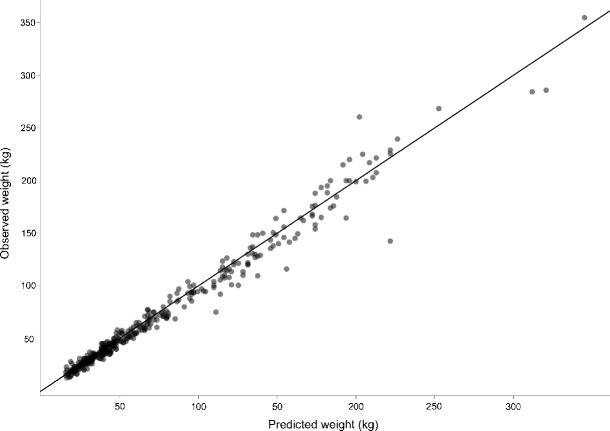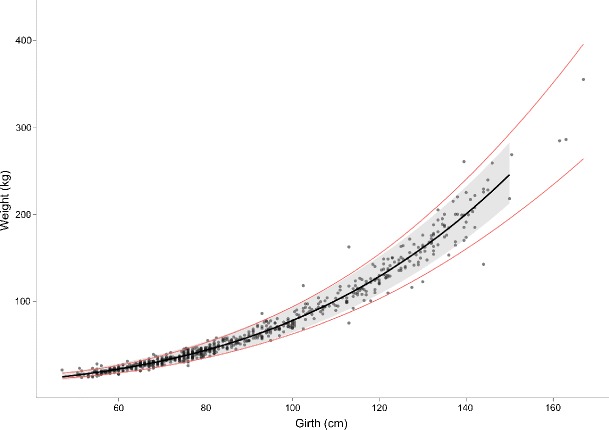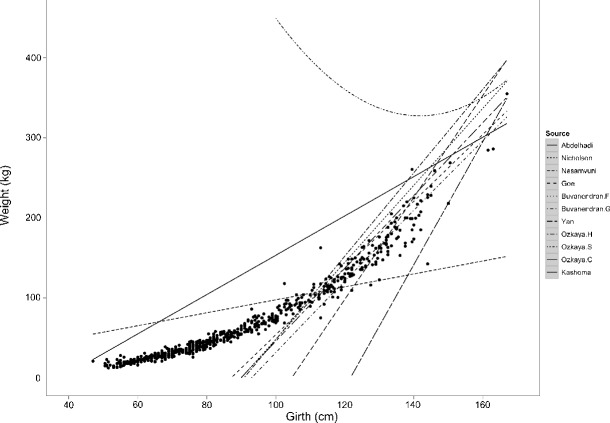Abstract
The accurate estimation of livestock weights is important for many aspects of livestock management including nutrition, production and appropriate dosing of pharmaceuticals. Subtherapeutic dosing has been shown to accelerate pathogen resistance which can have subsequent widespread impacts. There are a number of published models for the prediction of live weight from morphometric measurements of cattle, but many of these models use measurements difficult to gather and include complicated age, size and gender stratification. In this paper, we use data from the Infectious Diseases of East Africa calf cohort study and additional data collected at local markets in western Kenya to develop a simple model based on heart girth circumference to predict live weight of east African shorthorn zebu (SHZ) cattle. SHZ cattle are widespread throughout eastern and southern Africa and are economically important multipurpose animals. We demonstrate model accuracy by splitting the data into training and validation subsets and comparing fitted and predicted values. The final model is weight0.262 = 0.95 + 0.022 × girth which has an R 2 value of 0.98 and 95 % prediction intervals that fall within the ±20 % body weight error band regarded as acceptable when dosing livestock. This model provides a highly reliable and accurate method for predicting weights of SHZ cattle using a single heart girth measurement which can be easily obtained with a tape measure in the field setting.
Keywords: East African shorthorn zebu, SHZ, Weight estimation, Cattle, Heart girth, Dosing, Kenya
Introduction
The accurate estimation of livestock weights is important for many purposes such as determining ration amounts, agreeing on sale prices and for ensuring the correct therapeutic dosing of animals. East African shorthorn zebu (SHZ) are multipurpose animals that serve as sources of draught power, milk and meat and contribute to household incomes throughout eastern and southern Africa (Rege et al. 2001). Milk production is largely determined by reproductive performance, which is in turn closely correlated with cow weight and body condition (Kanuya et al. 2006). Similarly, the relationship between live weight and capacity for work in SHZ used as draught animals is well established (Bartholomew et al. 1994; Fall et al. 1997). It can thus be deduced that body weight can be used to evaluate the value of an animal intended for use as breeding stock, milk production, draught power or beef. A simple, accurate method of approximating SHZ body weight in the field will thus give farmers greater bargaining authority at cattle markets, maximising the economic return on the investments made in their animals.
Livestock pathogens, such as Trypanosoma sp., Babesia sp., Anaplasma sp. and Theiliera sp., remain important constraints to livestock production in east Africa, where the main control methods available to farmers are pharmaceuticals (Perry et al. 2002; Malak et al. 2012). However, underdosing of therapeutic pharmaceuticals not only fails to control pathogens but also leads to the development of antimicrobial-resistant bacteria through selection pressure (Spellberg et al. 2008; Morgan et al. 2011). Although the risk to human health has not been clearly defined, it is a major public health concern that the resulting antimicrobial-resistant genes will be transferred to bacteria pathogenic to humans, such as Campylobacter spp., Salmonella spp. and enterotoxigenic Escherichia coli, and enter the food chain or environment (Shuford and Patel 2005; Mathew et al. 2007; Gousia et al. 2011; Oliver et al. 2011). This may be of even greater concern in developing countries, where antimicrobial treatment options are limited by cost and availability (Okeke et al. 2005). Though rarely reported in the literature, there is also a risk associated with overdosing, which could lead to insufficient drug withdrawal times and increased risk of meat and milk residues, in addition to being wasteful and economically inefficient. Many of these issues are cause for concern in developing countries where access to reliable estimates of weight for dosing can be difficult to obtain and where the impacts of resistance are likely to be most severely felt and least likely to be monitored or controlled.
Weighing scales, though accurate, are not commonly available nor convenient for use in an African field setting. There are many studies (Buvanendran et al. 1980; Nicholson and Sayers 1987; Nesamvuni et al. 2000; Goe et al. 2001; Abdelhadi and Babiker 2009; Ozkaya and Bozkurt 2009; Yan et al. 2009) that have aimed to estimate weights from various body measurements, but these often require several measurements per animal, which is inconvenient, time-consuming and possibly dangerous (many animals in these settings are not as familiar with handling as European counterparts). European-based weigh tapes developed for Holstein or other European beef breeds consistently overestimate the true weight of SHZ cattle, which have very different conformations (Mwacharo et al. 2006; Machila et al. 2008). It is clear that the morphologically distinct SHZ, which comprise the majority of cattle in eastern and south-central Africa, will need their own predictive model of weight, and these may need to be complex functions over the full age range. Further, it has been found (Machila et al. 2008) that farmers consistently underestimate the live bodyweight of cattle, demonstrating the need for the development of an accurate and inexpensive method. Visual estimation of live weight in many livestock species is generally regarded as very inaccurate and prone to error. This manuscript uses statistical methods to develop and validate an accurate, statistical model for SHZ cattle live weight based on heart girth measurement.
Materials and methods
Data for the model came from two sources: a convenience sample of 241 cattle was selected at a number of livestock markets (Amukura, Kemodo, Funyula, Myanga, Ogalo, Bumala, Lugulu, Boro, Kocholya and Myanga) during June and July 2010, where some attempt was made to exclude animals with exotic genes through a seller questionnaire asking about origins and breeding, and at Mkura market in September 2010. All markets were in the Busia administrative district in a region of western Kenya near the Kenya–Uganda border. A further 462 observations were taken from the Infectious Diseases of East Africa (IDEAL) calf cohort study. Calves from 20 randomly selected sub-locations within a 45-km radius of Busia town were recruited and followed for the first 12 months of life. Each animal was observed at five weekly intervals, but to avoid issues of repeated measures, a single observation per calf was randomly drawn. The final data set therefore consisted of 703 SHZ cattle owned by smallholder farmers in western Kenya ranging in age from 1 week to fully mature. Each animal was weighed using either a pair of portable calibrated weigh beams (ZEMIC, model H8C-C3-1.5t-4B-SC) or a spring balance (for IDEAL calves up to 31 weeks of age). Their heart girth was measured using a simple measuring tape held with 1-kg tension using a light spring balance. Each animal’s sex and age (estimated via dentition in the case of market animals) were also recorded.
Statistical analysis was carried out using the R software program (R Development Core Team 2011). The data set was divided into two subsets, chosen by random selection, a modelling subset of slightly less than 50 % of the data was used to develop the statistical model and a validation set was used to validate the model. A likelihood maximised Box–Cox transformation,
Table 1.
Model equations of form weight = given equation, breed applied to and source
| Breed | Equation | Source |
|---|---|---|
| Fulani | 1,513 − 37.97 x + 0.3093 x 2 + 0.000749 x 3 | Buvanendran et al. (1980) |
| Gudali | − 438 + 4.88x − 0.001823 x 2 | Buvanendran et al. (1980) |
| Boran | − 432.73 + 4.81x | Nicholson and Sayers (1987) |
| Nguni | 16.58 + 0.81x | Nesamvuni et al. (2000) |
| Abyssinian SHZ | − 363 + 4.17x | Goe et al. (2001) |
| Baggara | − 92.472 + 2.4573x a | Abdelhadi and Babiker (2009) |
| Holstein | − 473 + 5.21x | Ozkaya and Bozkurt (2009) |
| Brown Swiss | 1,733.22− 19.84x + 0.07x 2 | Ozkaya and Bozkurt (2009) |
| Crossbred | − 935 + 7.69x | Ozkaya and Bozkurt (2009) |
| Holstein–Fresian | − 666.6 + 6.373x | Yan et al. (2009) |
| SHZ | − 409 + 4.55x | Kashoma et al. (2011) |
Notation has been standardised so that x always refers to cattle heart girth
aThe model in question used heart girth around the hump
Results
The complete data weight versus heart girth scatter plot is provided in Fig. 1, showing the modelling and validation data subsets. The modelling subset of 300 observations was used to fit the transformation and regression parameters. The Box–Cox transformation parameter, λ, was estimated to be 0.262. Gender, weaning status, interactions and higher order girth terms were found to be not significant once heart girth was in the model. A very simple linear model was fitted to the transformed data. The model is given as
| 1 |
where x i is the measured heart girth (in centimetre) for subject i and y i is the measured weight (in kilogram) for subject i. This resulting model had an adjusted R 2 of 0.98 and a residual standard error of 0.08.
Fig. 1.

Measured heart girth versus measured weight scatter plot for 703 African shorthorn zebu cattle. The model data set is indicated by circles and the validation data by triangles
The model was then used to predict weights based on heart girth measurements in the validation data set. Figure 2 shows the agreement between predicted weights and observed weights in the validation data set. 95 % prediction intervals were calculated and compared with the 20 % safe dosing zone, as established by (Machila et al. 2008), and this is shown in Fig. 3 where the model, prediction intervals and safe dosing zone have been back transformed for clarity. Figure 4 shows the result of fitting models from the literature to the complete data set; the model equations, breeds and citations can be found in Table 1.
Fig. 2.

Agreement between predicted weights applying the model developed on the training data set to the validation data set and the observed weights. The line of perfect agreement is overlaid on the plot
Fig. 3.

Complete data overlaid with the best fit model (thick solid line), 95 % prediction intervals (grey band) and the ±20 % body weight safe zone for dosing (thin solid lines). The model line and 95 % prediction intervals are those developed from the modelling data subset only
Fig. 4.

Complete data overlaid with models sourced from the literature. Model equations can be found in Table 1
Discussion
The proposed model for estimation of weight via heart girth measurements satisfies statistical and practical considerations. The model is highly significant, has a very high adjusted R 2 value, shows very good performance on the validation data set and, importantly, predicts weights for which the 95 % prediction intervals fall within the safe dosing zone. Because the model does not use sex or age to stratify results, it is very amenable to transfer onto a weight tape that can be used for all ages of SHZ cattle. The potential impact of this tool for smallholder farmers throughout eastern and southern Africa is far reaching, including the accurate dosing of animals to prevent selection for antimicrobial resistance, as well as accurate estimates of slaughter weight at market, which is the primary determinant of market price (Scarpa et al. 2003). As the data presented here show a clear nonlinear relationship between heart girth and weight and the majority of the literature-sourced models are linear, it is not surprising that they were not accurate at estimating weight for this data set. It is possible that breed conformation and animal maturity also play a role in the failure of other weight estimation models to fit the data as our animals. This analysis highlights the need to have appropriate measurement tools for different breeds and the dangers of trying to extrapolate from a model into a different breed and over a different age or size range; however, it seems clear that nonlinear models must be considered. Further research is required to determine if our model can be applied to other subgroups of zebu throughout Africa.
Acknowledgements
The authors would like to acknowledge the Wellcome Trust (grant no. 079445) that funded the data collection. We would also like to thank the Kenyan Government Veterinary Service for their support in the field and the farmers for allowing us to examine their animals.
Open Access
This article is distributed under the terms of the Creative Commons Attribution License which permits any use, distribution, and reproduction in any medium, provided the original author(s) and the source are credited.
Footnotes
An erratum to this article is available at http://dx.doi.org/10.1007/s11250-014-0555-z.
Contributor Information
Maia Lesosky, Email: lesosky@gmail.com.
Barend Mark de Clare Bronsvoort, Email: mark.bronsvoort@ed.ac.uk.
References
- Abdelhadi OMA, Babiker SA. Prediction of zebu cattle live weight using live animal measurements. Livestock Research for Rural Development. 2009;21(8):1–7. [Google Scholar]
- Bartholomew P, Khibe T, Little, D.A. Effect of liveweight and body condition on work output from draft oxen. Tropical Animal Health and Production. 1994;26:58–64. doi: 10.1007/BF02241135. [DOI] [PubMed] [Google Scholar]
- Box G, Cox D. An analysis of transformations (with discussion) Journal of the Royal Statistical Society. Series B. 1964;26:211–246. [Google Scholar]
- Buvanendran V, Umoh JE, Abubakar BY. An evaluation of body size as related to weight of three West African breeds of cattle in Nigeria. The Journal of Agricultural Science. 1980;95:219–224. doi: 10.1017/S0021859600029476. [DOI] [Google Scholar]
- Fall A, Pearson R, Fernandez-Rivera S. Nutrition of draught oxen in semi-arid west Africa. 3. Effect of body condition prior to work and weight losses during work on food intake and work output. Animal Science. 1997;64:227–232. doi: 10.1017/S1357729800015770. [DOI] [Google Scholar]
- Goe MR, Alldredge JR, Light D. Use of heart girth to predict body weight of working oxen in the Ethiopian highlands. Livestock Production Science. 2001;69:187–195. doi: 10.1016/S0301-6226(00)00257-8. [DOI] [Google Scholar]
- Gousia P, Economou V, Sakkas H, Leveidiotou S, Papadopoulou C. Antimicrobial Resistance of Major Foodborne Pathogens from Major Meat Products. Foodborne Pathogens and Disease. 2011;8:27–38. doi: 10.1089/fpd.2010.0577. [DOI] [PubMed] [Google Scholar]
- Kanuya NL, Matiko MK, Nkya R, Bittegeko SBP, Mgasa MN, Reksen O, Ropstad E. Seasonal changes in nutritional status and reproductive performance of Zebu cows kept under a traditional agro-pastoral system in Tanzania. Tropical Animal Health and Production. 2006;38(6):511–519. doi: 10.1007/s11250-006-4419-z. [DOI] [PubMed] [Google Scholar]
- Kashoma, I., Luziga, C., Werema, C., Shirima, G., and Ndossi, D. 2011. Predicting body weight of Tanzania shorthorn zebu cattle using heart girth measurements. Livestock Research for Rural Development, 23.
- Machila N, Fèvre EM, Maudlin I, Eisler MC. Farmer estimation of live bodyweight of cattle: implications for veterinary drug dosing in East Africa. Preventive Veterinary Medicine. 2008;87(3–4):394–403. doi: 10.1016/j.prevetmed.2008.06.001. [DOI] [PubMed] [Google Scholar]
- Malak A, Mpoke L, Banak J, Muriuki S, Skilton R, Odongo D, Sunter J, Kiara H. Prevalence of livestock diseases and their impact on livelihoods in Central Equatoria State, southern Sudan. Preventive Veterinary Medicine. 2012;104:216–223. doi: 10.1016/j.prevetmed.2011.12.001. [DOI] [PubMed] [Google Scholar]
- Mathew A, Cissell R, Liamthong S. Antibiotic Resistance in Bacteria Associated with Food Animals: A United States Perspective of Livestock Production. Foodborne Pathogens and Disease. 2007;4:115–133. doi: 10.1089/fpd.2006.0066. [DOI] [PubMed] [Google Scholar]
- Morgan D, Okeke I, Laxminarayan R, Perencevich E, Weisenberg S. Non-prescription antimicrobial use worldwide: a systematic review. The Lancet Infectious Diseases. 2011;11:692–701. doi: 10.1016/S1473-3099(11)70054-8. [DOI] [PMC free article] [PubMed] [Google Scholar]
- Mwacharo JM, Okeyo AM, Kamande GK, Rege JEO. The small East African shorthorn zebu cows in Kenya. I: Linear body measurements. Tropical Animal Health and Production. 2006;38(1):65–74. doi: 10.1007/s11250-006-4266-y. [DOI] [PubMed] [Google Scholar]
- Nesamvuni AE, Mulaudzi J, Ramanyimi ND, Taylor GJ. Estimation of body weight in Nguni-type cattle under communal management conditions. South African Journal of Animal Science. 2000;30(Supplement 1):97–98. [Google Scholar]
- Nicholson MJ, Sayers AR. Relationships between body weight, condition score and heart girth changes in Boran cattle. Tropical Animal Health Production. 1987;19:115–120. doi: 10.1007/BF02297329. [DOI] [PubMed] [Google Scholar]
- Okeke I, Lazminarayan R, Bhutta Z, Duse A, Jenkins P, O’Brien T, Pablos-Mendez A, Klugman K. Antimicrobial resistance in developing countries. Part I: recent trends and current status. The Lancet Infectious Diseases. 2005;5:481–493. doi: 10.1016/S1473-3099(05)70189-4. [DOI] [PubMed] [Google Scholar]
- Oliver S, Murinda S, Bhushan M. Impact of Antibiotic Use in Adult Dairy Cows on Antimicrobial Resistance of Veterinary and Human Pathogens: A Comprehensive Review. Foodborne Pathogens and Disease. 2011;8:337–355. doi: 10.1089/fpd.2010.0730. [DOI] [PubMed] [Google Scholar]
- Ozkaya S, Bozkurt Y. The accuracy of prediction of body weight from body measurements in beef cattle. Archiv Tierzucht. 2009;52:371–377. [Google Scholar]
- Perry B, Randolph T, McDermott J, Sones K, Thornton P. Investing in Animal Health Research to Alleviate Poverty. Nairobi: International Livestock Research Institute (ILRI); 2002. [Google Scholar]
- R Development Core Team . R: A Language and Environment for Statistical Computing. Vienna, Austria: R Foundation for Statistical Computing; 2011. [Google Scholar]
- Rege J, Kahi A, Okomo-Adhiambo M, Mwacharo J, Hanotte O. Zebu cattle of Kenya: Uses, performance, farmer preferences, measures of genetic diversity and options for improved use. Nairobi, Kenya: Animal Genetic Resources Research, ILRI (International Livestock Research Institute); 2001. [Google Scholar]
- Scarpa R, Ruto E, Kristjanson P, Radeny M, Drucker A, Rege J. Valuing indigenous cattle breeds in Kenya: an empirical comparison of stated and revealed preference value estimates. Ecological Economics. 2003;45:409–426. doi: 10.1016/S0921-8009(03)00094-6. [DOI] [Google Scholar]
- Shuford J, Patel R. Antimicrobial growth promoter use in livestock - implications for human health. Reviews in Medical Microbiology. 2005;16:17–24. doi: 10.1097/00013542-200501000-00003. [DOI] [Google Scholar]
- Spellberg B, Guidos R, Gilbert D, Bradley J, Boucher H, Scheld W, Barlett J, Edwards J, the Infectious Diseases Society of America The epidemic of antibiotic-resistant infections: A call to action for the medical community from the Infectious Diseases Society of America. Clinical Infectious Diseases. 2008;46:155–164. doi: 10.1086/524891. [DOI] [PubMed] [Google Scholar]
- Yan T, Mayne C, Patterson D, Agnew R. Prediction of body weight and empty body composition using body size measurements in lactating dairy cows. Livestock Science. 2009;124(1–3):233–241. doi: 10.1016/j.livsci.2009.02.003. [DOI] [Google Scholar]


